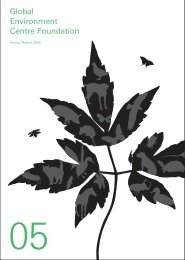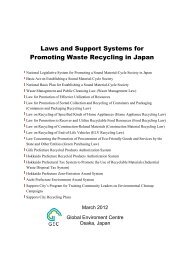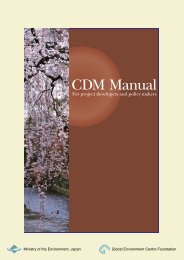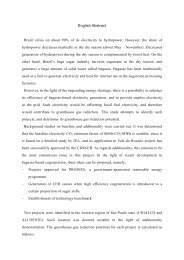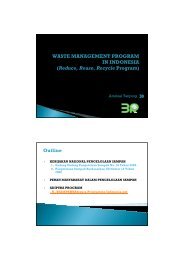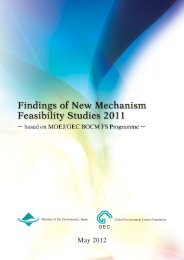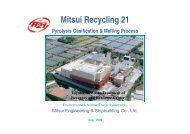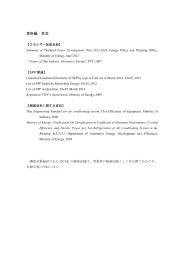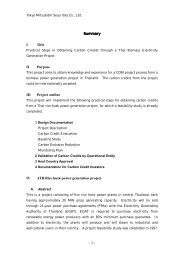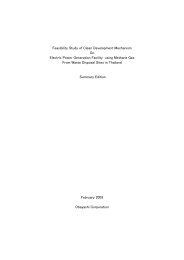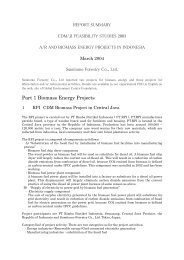PDF File - GEC
PDF File - GEC
PDF File - GEC
You also want an ePaper? Increase the reach of your titles
YUMPU automatically turns print PDFs into web optimized ePapers that Google loves.
3 Methodological Tools<br />
Table A-7 List of Methodological Tools (as of 14 Oct 08)<br />
Title and Version<br />
Number<br />
1. Tool for the<br />
demonstration<br />
and assessment<br />
of additionality –<br />
Version 5.2 [EB39,<br />
Annex 10]<br />
2. Combined tool<br />
to identify the<br />
baseline scenario<br />
and demonstrate<br />
additionality –<br />
Version 2.2 [EB28,<br />
Annex 14]<br />
3. Tool to calculate<br />
project or leakage<br />
CO2 emissions<br />
from fossil fuel<br />
combustion –<br />
Version 2 [EB41,<br />
Annex 11]<br />
4. Tool to determine<br />
methane<br />
emissions avoided<br />
from disposal of<br />
waste at a solid<br />
waste disposal<br />
site – Version 4<br />
[EB41, Annex 10]<br />
5. Tool to calculate<br />
baseline, project<br />
and/or leakage<br />
emissions<br />
from electricity<br />
consumption –<br />
Version 1 [EB39,<br />
Annex 7]<br />
Scope and<br />
applicability<br />
Scope and<br />
applicability<br />
Scope and<br />
applicability<br />
Parameter(s) to<br />
be determined<br />
Scope and<br />
applicability<br />
Parameter(s) to<br />
be determined<br />
Scope and<br />
applicability<br />
Parameter(s) to<br />
be determined<br />
Scope, Applicability and Parameters<br />
I. METHODOLOGY RELATED TOOLS<br />
The document provides a general framework for demonstrating and assessing<br />
additionality and is applicable to a wide range of project types. Some project<br />
types may require adjustments to this general framework. The steps include:<br />
• STEP 1. Identification of alternatives to the project activity;<br />
• STEP 2. Investment analysis;<br />
• STEP 3. Barriers analysis; and<br />
• STEP 4. Common practice analysis.<br />
This tool provides for a step-wise approach to identify the baseline scenario and<br />
simultaneously demonstrate additionality. Project participants proposing new<br />
baseline methodologies may incorporate this combined tool in their proposal.<br />
Project participants may also propose other tools for the identification of the<br />
baseline scenario and demonstrate additionality to the EB for its consideration.<br />
Methodologies using this tool are only applicable if all potential alternative<br />
scenarios to the proposed project activity are available options to project<br />
participants. This applies, for example, to project activities that make modifications<br />
to an existing installation that is operated by project participants, such as, for<br />
example:<br />
• energy efficiency improvements at existing installations operated by project<br />
participants;<br />
• fuel switch at existing installations operated by project participants;<br />
• changes in waste management practices at existing solid waste disposal sites<br />
operated by project participants;<br />
• reduction of N 2 O, HFC-23 or PFC emissions at existing installations operated by<br />
project participants.<br />
The methodological procedure involves the following four steps:<br />
• STEP 1. Identification of alternative scenarios<br />
• STEP 2. Barrier analysis<br />
• STEP 3. Investment analysis (if applicable)<br />
• STEP 4. Common practice analysis<br />
This tool provides procedures to calculate project and/or leakage CO 2 emissions<br />
from the combustion of fossil fuels. It can be used in cases where CO 2 emissions<br />
from fossil fuel combustion are calculated based on the quantity of fuel<br />
combusted and its properties. Methodologies using this tool should specify for<br />
which combustion processes j this tool is being applied.<br />
CO 2 emissions from fossil fuel combustion in process j during the year y (tCO 2 /yr)<br />
[PE FC,j,y ]<br />
This tool calculates baseline emissions of methane from waste that would in the<br />
absence of the project activity be disposed at solid waste disposal sites (SWDS).<br />
The tool is not applicable to stockpiles. Emission reductions are calculated with<br />
a first order decay (FOD) model. The tool is applicable in cases where the SWDS<br />
where the waste would be dumped can be clearly identified. The tool is not<br />
applicable to hazardous wastes.<br />
Methane emissions avoided during the year y from preventing waste disposal at<br />
the SWDS during the period from the start of the project activity to the end of<br />
the year y (tCO 2 e) [BE CH4,SWDS,y ].<br />
This tool provides procedures to estimate the baseline, project and/or leakage<br />
emissions associated with the consumption of electricity. The tool may, for<br />
example, be used in methodologies where auxiliary electricity is consumed in the<br />
project and/or the baseline scenario. The tool can also be applied in situations<br />
where electricity is only consumed in the baseline or in the project or as leakage<br />
source. This tool is not applicable in cases where captive renewable power<br />
generation technologies are installed to provide electricity in the project activity,<br />
in the baseline scenario or to sources of leakage. This tool only accounts for CO 2<br />
emissions. This tool also refers to the latest approved version of the following<br />
tools:<br />
• “Tool to calculate the emission factor for an electricity system”;<br />
• “Tool to calculate project or leakage CO 2 emissions from fossil fuel<br />
combustion”.<br />
• Project emissions from electricity consumption in year y (tCO 2 /yr) [PE EC,y ]<br />
• Baseline emissions from electricity consumption in year y (tCO 2 /yr) [BE EC,y ]<br />
• Leakage emissions from electricity consumption in year y (tCO 2 /yr) [LE EC,y ]<br />
95



